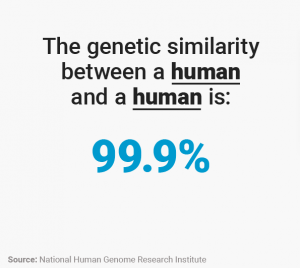What is the Connection? Find Commonalities for Better Conversations
Conversations bring people together or drive people apart based on our perceived commonality or differences. All humans are 99% alike from a DNA perspective. What is missing from the equation for harmony is just the perception of similarity. Luckily, our perceptions can be changed. With a bit of intention and effort, we can perceive others as similar to us and increase the chances we can get along.
I invite you to experiment with two methods for finding connections and improving interpersonal interactions. The first is discovery of similarity and the second is reminder of humanity.
Discovery of Similarity
We can find surface-level commonality with people we meet, such as a hobby or an element of our work. Taking it on as a discovery process can be fun. Austin, Nevada City, San Francisco, Tampa – what is the connection? Places I’ve travelled in the past month and met people just like me. They might be a different gender, from a different culture, or their skin might be a different color, but we can still find commonalities. Meeting new people, what comes to my mind first is: What do I have I common with this person? I discover connections by asking questions: ‘where are you from?’ ‘what do you do for fun/work/hobbies?’ ‘how was your weekend?’ These small talk methods are simple ways to find connections. Typically, conversations will proceed at a surface level with these types of connection creators until we find something in common. Then we tend to dive deeper into that topic, be it food, kids, sport, music, books, or recent movies. Generally, it feels good to be connected, but that is not always how it goes.
Reminder of Humanity
Sometimes initial interactions seem to bring up differences rather than commonalities. They may reveal a difference in culture or political leanings. In these cases, we may feel separation and perceive that the ‘other’ is not like us. It is in these times when we can remind ourselves of all being human – that we are 99% like each other. As humans, we have more in common than we have as differences. The exercise here is to repeat the phrase ‘just like me’ and follow it by a basic human condition: ‘just like me this person wants to be understood,’ ‘just like me this person is forming their opinions based on information they have received,’ ‘just like me they want to be healthy, happy, and loved.’ In really challenging situations it is helpful to drop to an even more basic level: ‘this person has a beating heart and their lungs are filling with oxygen, just like me,’ ‘this person is somebody’s daughter/son, just like me.’
Human commonalities are so much more significant than a political opinion, religious practice, or social norm. When we see this reality of sameness as more significant than difference, our perspective changes. With that internal perspective shift comes a subconscious change in body language – facial expressions and stance – that others perceive. It often also leads to a shift in our language to be more inclusive and accepting. The result is the other person feels more accepted and is more inclined toward getting along.
For example, in a recent interaction someone used the term ‘God fearing’ frequently in conversation. At first, I was put off by the term as it reminded me of the judgment I felt from some religious people having grown up Catholic. That brought up difference instead of sameness in my mind. Then I remembered that we were both human and I made a conscious choice to listen for commonalities from this person. I heard common values of family and integrity and dedication. With that I was able to shift my perception toward sameness and I could hear the term ‘God fearing’ to mean trusting in and leaning on a belief in times of uncertainty. We had in common the human desire to feel a sense of security.
This skill of seeing commonality takes time to develop, and it can be helpful to practice on strangers with whom we are not interacting. Airports are a perfect practicing ground. Particularly with people for whom our initial reaction is irritation or judgement. I practice the ‘just like me’ exercise and seek to find a commonality. I see that the person standing in the wrong line has a kid in tow and I remember what it was like to travel with young ones. I hear that the person talking loudly on the phone next to me is appeasing an upset boss and I connect with the feeling of being stressed and striving to meet high expectations. Once I find something in common, I am amazed at how quickly my perspective and attitude toward them changes. I also enjoy this free ‘Just Like Me’ meditation.
The start of every good conversation begins with a connection between people. When we find that connection it changes our perspective and likely our language and approach to interacting with that person, bringing us together instead of driving us apart.

